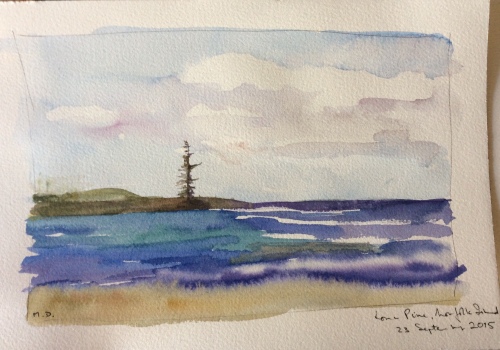My sister lives outside Pomona, a small township in the Sunshine Coast hinterland. One Saturday, nearly 20 years ago, we decided to go to the agricultural show together in the neighbouring town of Cooroy.
I love agricultural shows – not the big commercial jobs like the Ekka or the Royal Easter, full of overpriced rides and rip-off show bags – but the small local affairs. These used to be a staple of every small town, with the CWA selling tea and sandwiches, reps demonstrating new harvesters and post-hole diggers, and competitions for the best cakes and fat lambs.
They are now a dying breed, like the fat lambs. Tastes have changed, from cake stalls to sausage sizzles, and farmers buy their agricultural machinery after doing their research on the web. (Or they do in South East Queensland – my sister has the NBN, whereas I’m still waiting for it here on the outskirts of Brisbane.)
In 1998, Cooroy teetered on the edge of the new economy. Since then the butter factory has reopened as an Arts Space, the timber mill has closed, but there’s a new microbrewery. The area is full of refugees from high house prices, not just in Brisbane, but from Sydney and Melbourne as well, and telecommuters in the knowledge economy are thick on the ground. People from the other, older economy have been left behind. Within an hour’s drive of Noosa are some of the poorest postcodes in Queensland.
The Cooroy Show should have rung clearer bells, though at the time I just found it curious that, amongst the cakes and cultivators, 2 groups stood out: there were several booths advertising the One Nation Party, which was just gearing up for the Queensland election, and there were alpacas wherever you looked. Both were attracting queues.
I’ve always associated Pauline Hanson with alpacas ever since: the short curly topknot, the stiff neck and square jaw, fiercely defensive of the group they are protecting, the tendency to spit…. And then there are those cute alpacas.
The people in the queues at Cooroy in the late 1990s were at the end of their tether, their way of life under threat from economic changes they could not control. Dairying was failing, the timber industry too, the market for canned pineapples and vegetables had shrunk. At the same time, big producers were taking over strawberries and tomatoes, with the capital to install hothouses and hydroponics. (James Ashby was spokesman for one of these new strawberry farms, at Beerwah, when its hydroponics system was mysteriously poisoned.)

Suri alpacas, from Wikipedia
The salesmen with their alpacas appealed to desperate people. Australians have always had a tendency to seize on new agricultural fads in their never-ending ‘search for a staple’, the Next Big Thing, ever since John Macarthur imported merino sheep in a ship he renamed the Argo in honour of the Golden Fleece. Some of these products, like merinos, took off. Most become at best a niche market, some disappear entirely. Remember when jojoba beans were a Thing?
The first alpacas were imported into Australia in 1858. A few years earlier, the NSW Governor and the businessman Thomas Mort decided that alpacas might be the New Big Thing. They asked Charles Ledger, an Englishman who bred alpacas in Peru, to import some of the animals and he finally arrived in Sydney with a group of South American shepherds and a flock of over 200 alpacas, llamas and vicunas, after a hair-raising journey (for men and beasts alike) from Peru to Bolivia to Argentina to Chile and finally across the Pacific to NSW.
Unfortunately by the time he arrived, the Government had changed and nobody was interested in alpacas any longer. Henry Parkes took his daughter Clarinda to see some of them at the Sydney Domain.
At Cooroy the slick alpaca salesmen didn’t talk about wool or meat – or even the alpaca’s potential value as a guardian animal amongst a herd of sheep. They talked about how valuable they were as breeding animals, because after buying high, next year the farmer could sell on their offspring for equally high prices. It was all a bit like a pyramid scheme – but for desperate people the promise of breeding alpacas represented the last throw of the dice.
At the One Nation booths there were also slick salesmen. Those people filling in forms and paying their money thought they were signing up as members of the new political party – it later turned out they were just ‘supporters’, with no input into party policy, and in 2002 the party was deregistered for not having the necessary 500 members.
Like alpacas, though, the One Nation Party represented a last throw of the dice. A few years later, their neighbours in Fairfax elected a noisy, plausible businessman, Donald-Trump-lite Clive Palmer.
In The Saturday Paper [paid link] yesterday, Karen Middleton has a fascinating article about ‘One Nation’s business model’. She quotes a number of disaffected ex-PHON party members from Western Australia. ‘It’s not a political party’, said a former president of the WA branch, Lyn Vickery. ‘Most political parties under the electoral act are supposed to be incorporated associations. That’s what the electoral commission prefers. This is in fact a business. And in fact it’s a pyramid business, much like Amway.’
The trouble with pyramid schemes is that they depend on growth. Without constantly expanding, they invariably collapse. A pity most of them aren’t as cute as alpacas.













